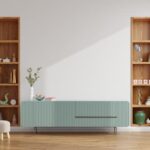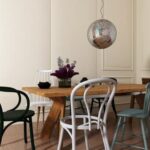Decorating a split level home can be a unique challenge, as these homes feature distinct layouts that require innovative solutions to maximize space and create a cohesive design. With multiple levels and an open floor plan, finding the right balance and flow can be key to turning your split level house into a stylish and functional home.
Understanding the layout of your split level home is crucial in order to make informed decorating decisions. Each level serves a specific purpose, whether it be for living, dining, or sleeping areas. Knowing how these levels connect and impact each other will help you plan your design effectively.
Creating focal points in each level or area of the home is essential to anchor the overall design. Focal points can be established with elements such as fireplaces, artwork, or furniture arrangements that draw attention and set the tone for the space. By carefully selecting the right focal point for each level, you can ensure a visually appealing and harmonious atmosphere throughout your split-level home.
Incorporating innovative storage solutions is also crucial when decorating a split level home. With limited square footage, making use of vertical space is essential. High ceilings, tall walls, and stairwells can serve as opportunities for displaying artwork or incorporating vertical storage solutions. By thinking creatively about how to utilize every inch of your home’s verticality, you can optimize both storage and aesthetic appeal.
As you embark on the journey of decorating your own split level home, keep these challenges in mind along with our tips and strategies for creating a cohesive and stylish design. With thoughtful planning and creativity, you can transform your split-level house into a welcoming and beautiful space that suits your lifestyle.
Understanding the Layout
When it comes to decorating a split level home, understanding the layout is essential. These unique homes are characterized by having multiple levels that are typically interconnected by short sets of stairs. The open floor plan is another noteworthy feature of split level homes, which can pose both challenges and opportunities for decoration.
One advantage of split level homes is that they often offer distinct areas for different activities, such as living spaces on one level and bedrooms on another. This separation can provide privacy and allow for more focused decoration in each area. Additionally, the open floor plan in many split level homes creates a sense of spaciousness and fluidity, making it easier to create a cohesive design throughout the home.
However, the open layout can also present challenges when it comes to zoning different areas and maintaining visual harmony. Without proper planning, there may be a lack of defined spaces or difficulty in creating a flow between different levels. Balancing the urge for an open concept with creating functional zones can be tricky but not impossible.
To overcome these challenges, consider using furniture placement strategically to define specific areas within each level or section of your home. Rugs can also be used to anchor furniture groupings and visually separate spaces while maintaining openness. Room dividers or screens can provide additional privacy without sacrificing natural light or airflow.
Another consideration when working with split level layouts is maintaining consistency in design themes or styles throughout all levels. This helps create visual unity and prevents disjointed aesthetics that could make your home feel disconnected. By choosing complementary color palettes, consistent flooring materials, and coordinating decor elements across different levels, you can achieve a harmonious look that ties everything together.
In summary, understanding the unique features of split level homes, such as their multi-level layout and open floor plan, is crucial for effective decoration. While these characteristics may present challenges, they also offer opportunities for creating distinct areas and a sense of flow. By carefully zoning different spaces, maintaining a cohesive style, and utilizing smart furniture placement, you can transform your split level home into a beautifully decorated space that maximizes both its unique design elements and functionality.
Creating a Focal Point
In a split level home, creating a focal point is crucial to anchor the design and draw attention in each level or area of the house. A well-placed focal point can enhance the overall aesthetic and provide a sense of balance and cohesiveness. When selecting a focal point, there are several options to consider, such as a fireplace, artwork, or furniture arrangement.
One option for a focal point in a split level home is a fireplace. A fireplace can serve as the centerpiece of a living room or family room, creating a cozy and inviting atmosphere. Consider positioning furniture around the fireplace to create a comfortable seating area that emphasizes this focal point. Choose a stylish mantel and surround that complements the overall design style of your home.
Artwork can also be an excellent focal point in different levels or areas of a split level home. Consider hanging bold or large-scale artwork on walls that are visible from multiple levels. This can create visual interest and draw attention to specific areas of the house. When selecting artwork, choose pieces that reflect your personal style and tie in with the color scheme and theme of your home.
Furniture arrangement can also serve as an effective focal point in a split level home. Arrange furniture strategically to highlight certain areas or architectural features. For example, placing an interesting piece of furniture near a staircase or at the top of a landing can draw attention to these unique aspects of your home’s layout. Additionally, consider using furniture with distinct shapes or colors to make it stand out as a focal point.
Overall, establishing focal points in each level or area of your split level home is essential for creating cohesion and visual interest. Whether it’s through a fireplace, artwork, or furniture arrangement, choosing the right focal points can greatly enhance the overall design aesthetic and make your space more inviting.
| Focal Point Options | Description |
|---|---|
| Fireplace | A fireplace can serve as the centerpiece of a living room or family room, creating a cozy and inviting atmosphere. |
| Artwork | Hanging bold or large-scale artwork on walls that are visible from multiple levels can create visual interest and draw attention to specific areas of the house. |
| Furniture Arrangement | Strategically arranging furniture can highlight certain areas or architectural features, making them stand out as focal points. |
Utilizing the Vertical Space
One of the unique features of split level homes is their verticality, which presents various opportunities for creative design solutions. Taking advantage of the vertical space in your split level home can help maximize functionality and create a visually appealing atmosphere. Here are some ideas on how to utilize the vertical space in your home:
- Displaying Artwork: High ceilings and tall walls in split level homes provide ample space for showcasing artwork. Consider hanging large-scale paintings or photographs on those expansive walls to create a dramatic focal point. Alternatively, you can arrange a gallery wall with a mix of smaller artworks to add visual interest. By utilizing vertical space for art displays, you can enhance the overall aesthetics of your home.
- Incorporating Vertical Storage Solutions: Split level homes often present challenges when it comes to storage space due to their unique layouts. However, embracing the vertical nature of these homes can offer creative storage solutions. Consider installing floor-to-ceiling shelving units along one wall or using tall bookshelves that not only serve as storage but also visually balance out the height of the room.
- Making Use of Stairwells: The stairwells in split level homes can be used as additional areas for functional and decorative purposes. Install floating shelves or built-in cubbies along the side of the staircase to display plants, books, or decorative items. This not only adds functionality but also transforms an otherwise unused space into a focal point.
- Vertical Gardens: Another way to utilize vertical space is by creating a vertical garden indoors or outdoors if you have balconies or patio areas in your split level home. Install hanging planters on walls or use trellises and climbing plants to add greenery and a touch of nature to your home decor.
By taking advantage of the vertical space in your split level home, you can create a visually appealing and functional living environment. Incorporating artwork, vertical storage solutions, stairwell decorations, and even vertical gardens can help maximize the use of space while adding personality and style to your home’s design.
Cohesive Color Scheme
One of the key aspects in decorating a split level home is creating a cohesive color scheme. A unified color palette throughout the different levels of the home helps to ensure continuity and flow, making the space feel harmonious and well-designed. When selecting colors for your split level home, there are a few considerations to keep in mind.
Firstly, it’s important to choose complementary colors that work well together. This means selecting hues that are opposite each other on the color wheel, such as blue and orange or green and red. Complementary colors create visual interest and balance in a space, adding depth and dimension to your decor.
Incorporating accent hues is another way to enhance the overall ambiance of your split level home. Accent colors can be used sparingly throughout the space to add pops of color and create focal points. For example, if you have a neutral color scheme with shades of gray or beige, you can introduce vibrant accent colors like mustard yellow or teal through accessories such as throw pillows, artwork, or rugs.
To maintain a cohesive look, it’s also important to consider how the different levels of your split level home connect visually. You can achieve this by using a common color as a thread throughout the various spaces. For instance, if you have an open floor plan with a living room on one level and a dining area on another level, you can use accents of the same color in both areas to visually tie them together.
By carefully selecting complementary colors and incorporating accent hues strategically, you can create a harmonious ambiance in your split level home. This will help bring unity and cohesiveness across different levels and spaces within your unique layout.
Zoning Different Levels
Split level homes often come with the challenge of open floor plans, which can make it difficult to define specific areas and create distinct zones. However, with some strategic planning and creative design solutions, it is possible to overcome these challenges and create a visually appealing and functional space.
One effective strategy for zoning different levels in a split level home is through furniture placement. By strategically arranging furniture, you can create designated areas within the open space. For example, you can arrange a sofa and chairs to create a cozy seating area in one level, while positioning a dining table and chairs in another level to establish a separate dining space. This not only helps define different areas but also provides functionality and visual appeal.
Another way to zone different levels is by using rugs. Placing rugs in various parts of your split level home can help visually separate different areas while still maintaining an overall sense of openness. Opt for rugs that are large enough to anchor furniture groupings and extend beyond each designated zone. This will help define the spaces without creating harsh boundaries.
Room dividers are also useful tools when it comes to zoning different levels in a split level home. They offer both visual separation and flexibility since they can be moved or adjusted as needed. Room dividers can be anything from folding screens or bookshelves to translucent panels or curtains. Choose options that match your overall decor style while providing the privacy or division you desire.
Lighting Solutions
Proper lighting is crucial in enhancing the overall ambiance and functionality of split level homes. With their unique layout and different levels, it is important to carefully consider the lighting design to create a cozy and inviting atmosphere throughout the space. In this section, we will explore the significance of lighting in split level homes and provide suggestions for incorporating ambient, task, and accent lighting to emphasize different areas.
One of the key considerations when designing the lighting for a split level home is to create a seamless transition between the different levels. This can be achieved by using consistent lighting fixtures and finishes throughout the space. For example, recessed downlights can be installed in hallways or stairwells to ensure safe navigation between levels while maintaining a cohesive look.
In addition to general ambient lighting, it is important to incorporate task lighting in specific areas where focused illumination is needed. Task lighting can be used in functional areas such as kitchen countertops, office spaces, or reading nooks. Pendant lights or under-cabinet lighting can be great options for providing task lighting without compromising on style.
Accent lighting plays a crucial role in highlighting architectural features or artwork in split level homes. Use track or picture lights to draw attention to focal points such as artwork, mantels, or architectural details. This helps create visual interest and adds dimensionality to the space.
Overall, achieving proper lighting solutions in a split level home requires a careful balance of ambient, task, and accent lighting. It’s important to consider both functionality and aesthetics when selecting light fixtures and determining placement. By creating a cohesive and well-designed lighting plan, you can enhance both the overall ambiance and functionality of your split level home.
| Lighting Type | Suggested Areas | Tips |
|---|---|---|
| Ambient Lighting | Main living areas, hallways | Use consistent lighting fixtures and finishes throughout the space to create a seamless transition between levels. |
| Task Lighting | Kitchen countertops, office spaces, reading nooks | Incorporate pendant lights or under-cabinet lighting to provide focused illumination in functional areas. |
| Accent Lighting | Artwork, mantels, architectural details | Add track or picture lights to highlight focal points and create visual interest in specific areas. |
Maximizing Storage
Utilizing Under-Stair Storage
One of the most effective ways to maximize storage in a split level home is by utilizing the often overlooked space under the stairs. This area can be transformed into a functional storage space with built-in cabinets, shelves, or drawers. Installing pull-out trays or baskets can make accessing items easier and more organized.
For smaller items such as shoes or bags, consider adding hooks or hanging racks to the underside of the stairs. This can free up valuable floor space while keeping these items easily accessible. Another option is to install open shelving along the stairs, creating both storage and a visually appealing display area for books or decorative objects.
Built-In Shelving
Incorporating built-in shelving into your split level home can not only provide additional storage but also add architectural interest and style. Look for alcoves, niches, or walls that can accommodate built-in shelves. These shelves can be customized to fit your specific needs, whether it’s displaying books, showcasing collectibles, or organizing everyday items.
Consider installing floor-to-ceiling shelves in taller areas of your split level home to take full advantage of the vertical space. This creates ample storage without overcrowding the room and helps draw attention upwards, making the space feel larger. To maintain a cohesive design aesthetic, paint or stain the shelves in a complementary color to blend seamlessly with the surrounding décor.
Multifunctional Furniture
In a split level home where space may be limited, choosing furniture that serves multiple purposes is key. Look for pieces such as ottomans with hidden storage compartments or coffee tables that double as workspace desks when needed. Sofa beds are also excellent options for providing an extra sleeping area for guests.
Consider investing in furniture that has built-in storage solutions, such as bed frames with drawers underneath or dining tables with hidden leaf extensions that create more surface area. This allows you to make the most of your space without sacrificing style or functionality.
By maximizing storage in a split level home, you can keep your living space organized and clutter-free. Whether it’s utilizing under-stair storage, incorporating built-in shelving, or selecting multifunctional furniture, there are numerous clever solutions available to optimize space and create a more functional environment.
Balancing the Décor
In order to create a cohesive and visually appealing design in a split level home, it is crucial to maintain a balanced and proportional aesthetic throughout the space. The distinct levels and open floor plan of these homes can present challenges when it comes to creating harmony between different areas. However, with some careful planning and consideration, you can achieve a well-balanced decor that harmonizes all levels while still allowing each area to have its own unique identity.
When selecting furniture and decor for your split level home, it is important to choose pieces that complement each other and create visual interest without overwhelming the space. Start by considering the scale and proportion of your furniture in relation to the size of each level or area. Avoid purchasing oversized furniture that may make smaller spaces feel cramped or cluttered. Instead, opt for pieces that fit comfortably within the allotted space while still providing ample seating or storage.
In terms of style, aim for continuity throughout the different levels while incorporating elements that distinguish each area from one another. This could be as simple as using a consistent color scheme or selecting furniture with similar design elements throughout. However, don’t be afraid to introduce subtle variations within this framework to add personality and visual interest. For example, you could choose contrasting accent colors or experiment with different textures and materials.
Additionally, consider the flow of traffic within your split level home when arranging furniture. Ensure there are clear pathways between different areas and avoid blocking access points such as stairwells or doorways. This will help maintain balance by ensuring an open and inviting feel in every part of your home.
By following these tips for selecting furniture and decor, you can achieve a balanced and proportional aesthetic in your split level home. It’s all about finding the right balance between unity and diversity – creating a design that ties everything together while highlighting the individuality of each level or area. With careful consideration given to scale, style, flow, and personal taste, you can transform your split level home into a harmonious and visually stunning living space.
Conclusion
In conclusion, decorating a split level home requires thoughtful consideration and innovative solutions to maximize space and create a cohesive design. Throughout this blog post, we have explored the distinct features and challenges of split level homes, and provided tips and strategies for navigating these obstacles.
One key aspect to keep in mind when decorating a split level home is the importance of establishing a focal point in each level or area. Whether it be a fireplace, artwork, or furniture arrangement, a well-defined focal point can anchor the design and draw attention. Additionally, utilizing the vertical space within your home can greatly enhance its aesthetics. High ceilings, tall walls, and stairwells can all act as opportunities for displaying artwork or incorporating vertical storage solutions.
Another crucial consideration is maintaining a cohesive color scheme throughout your split level home. A unified palette will ensure continuity and flow between different levels and areas. By selecting complementary colors and incorporating accent hues, you can create a harmonious ambiance that ties everything together.
Moreover, zoning different areas within an open floor plan can be challenging but essential for functionality. Clever furniture placement, rugs, and room dividers can help define specific spaces while maintaining a sense of openness in your split level home.
Lastly, proper lighting is vital in enhancing the overall ambiance and functionality of your split level home. Incorporating ambient, task, and accent lighting can emphasize different areas while creating a cozy atmosphere.
As you embark on your journey of decorating your own split level home, remember to balance both the proportions and the aesthetics. Selecting furniture and decor that harmonize with the different levels will create visual interest without overwhelming the space.
We hope that this blog post has provided you with valuable insights and inspiration for transforming your split level home into an inviting haven that reflects your unique style. Remember to approach each challenge as an opportunity for innovation, and don’t be afraid to experiment with different ideas until you achieve your desired look. Good luck on all your decorating endeavors.
Frequently Asked Questions
How can I make my split-level house look better?
To make a split-level house look better, consider updating the interior and exterior elements. Start with the curb appeal by improving the landscaping and giving the front façade a fresh coat of paint or adding new siding. Enhance the entryway by installing a stylish front door and updating the porch area with new lighting fixtures or potted plants.
Inside, focus on creating an open and cohesive feel by removing any unnecessary walls or barriers between spaces. Introduce modern finishes such as hardwood floors, updated light fixtures, and contemporary paint colors to give each level its own distinct style while maintaining a cohesive overall design. Additionally, consider bringing in natural light through larger windows or even skylights to provide an airy and inviting atmosphere.
How do you add value to a split-level house?
Adding value to a split-level house can be achieved by focusing on both functional improvements and aesthetic upgrades. Remodeling the kitchen and bathrooms are popular ways to add value, as these rooms are often key selling points for potential buyers. Replacing outdated appliances with energy-efficient models and using quality materials for countertops, cabinets, and fixtures will not only enhance the functionality but also increase its value.
Consider expanding living spaces by finishing unfinished areas like basements or converting garages into additional family rooms or bedrooms, thereby increasing usable square footage. Lastly, upgrading mechanical systems such as HVAC units or implementing smart home technology can also boost the value of a split-level house.
How do you modernize the exterior of a split-level?
To modernize the exterior of a split-level house, focus on creating clean lines and contemporary finishes while maintaining harmony with its architectural style. Start with freshening up existing elements – repaint the exterior surfaces in neutral shades or earth tones that complement neighboring homes without straying too far from their original character. Introduce modern materials such as fiber cement siding or metal accents to update the overall aesthetic appeal while still respecting the original design intent of the split-level architecture.
Shift towards more minimalistic landscaping designs by incorporating sleek pathways lined with low-maintenance plants and incorporating outdoor lighting to highlight the house’s architectural features during the evening hours. Lastly, pay attention to small details such as updating the front door, adding modern house numbers, and installing contemporary light fixtures to enhance the overall modern feel of the split-level home.

I’m thrilled to be your companion on this exciting journey through the world of home decor and design. With a passion for turning houses into homes and a keen eye for the finer details, I’m here to help you transform your living spaces into beautiful, functional, and meaningful havens.





